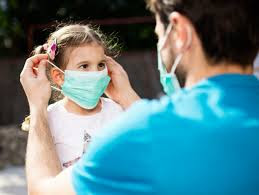How can we ensure children wear face mask properly.
Parents can ensure children wear face mask properly by covering over their nose and mouth by taking the following steps:

1. Explain to your child why face masks are important
Start by teaching your child on
why wearing a half face mask is
vital to help prevent the extent of COVID-19. Use age-suitable language to talk
to your child about coronavirus.
For younger children, stick to
modest, concrete terms. You can say things like wearing a mask benefits us to
be safe and keep others around us safe,' or ‘Wearing a mask can help guard us
and others against germs. It's useful to be consistent in how you explain this
and saying this message over and over.
For mature children, you can share
more material and refer to trusted resources such as the CDC for illustrations
that display how masks can help stop the virus from spreading.
Public health actions, such as
wearing a mask, are crucial to getting the spread of the virus under control. It
is significant to allow children with the knowledge that they can save a life
and that they are playing a vital role in fighting the pandemic.
2. Normalize face masks through play
Children acquire through play, and
this can similarly help them process their feelings. Give your child a mask for
their desired stuffed animal, sew a matching mask for a doll, or create masks
on characters in coloring books. Practice placing the mask on their toy and
consider having your child practice wearing the mask wit0h the toy to stabilize
the situation.
Listen to what your kid is saying
as he or she plays; it's a good way for parents to learn how their child is considering
or feeling about a situation.
3. Provide fun and colorful mask options
As face masks become more mutual,
it's becoming easier to find kid-friendly designs and options. Look for cloth half face mask that shows your
child's favorite color or character. You can even have your child help select a
design, so they feel a part of the practice.
If conceivable, have a few
different mask options for your child, so they can choose which mask they want
to wear that day. This can help stop any battles when requesting them to put on
their mask.
When looking at a kid-friendly mask
options, make sure you pick a cloth face covering that is easily washable and
sized for your child's age.
4. Ensure your child's mask fits correctly and comfortably
Making sure your kid's mask fits properly
and comfortably will help stop them from playing with it. Use mask to cover nose and mouth so it fit your
child's and be protected under their chin. Avoid any holes on the sides by
adjusting the mask's fit so it is comfortable. Always ensure that your child
can breathe easily when wearing the mask. When putting on your child's mask, or
when training your child how to wear their mask, make sure you or your child every
time wash your hands first.
5. Enlist your child's help
Giving kids a job or
responsibility can aid them to feel empowered and more in control of a condition.
Elect your child as the family "mask monitor." When going out of the
house, have them check that everybody has their mask available. You can request
older siblings to help younger siblings by reminding them to wear their masks.
It can also aid to keep your child's
hands full of activity when wearing a mask. For example, if you are in a
grocery store, ask your kid to help you carry an item. This can help avoid them
from touching their mask.
6. Practice wearing a mask
Whenever you present something new
into your child's atmosphere, it can help to exercise and gently get them
comfortable with the change. Before taking your child out in public in a mask,
practice putting on the mask and wearing it for small periods around your home.
You can look in the mirror to clarify how it must fit and start with just a few
minutes. You can choose the best neck gaiter
also to protect you from sunlight and germs.
7. Model healthy behavior: Wear your mask!
One of the finest ways to reassure
your child to wear a face mask is to wear one yourself. Kids are every time
listening and watching. They will notice how you talk about face masks and how
you respond when wearing one – and they will monitor your lead.
When wearing a mask can be an
adjustment, try to use optimistic language and support why wearing a face mask
is helpful for your family and others in the community. Concentrating on the
things you can control and thinking positively can go a long way in decreasing
anxiety about COVID-19.
Comments
Post a Comment